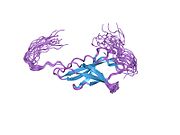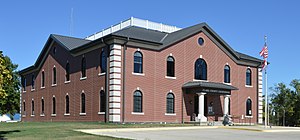NRCAM
NRCAM뉴런 세포 접착 분자는 인간에서 NRCAM 유전자에 의해 암호화된 단백질이다.[5][6]
세포 접착 분자(CAMs)는 면역글로불린 슈퍼 패밀리의 일원이다.이 유전자는 복수의 면역글로불린 유사 C2형 영역과 섬유소넥틴 타입 III 영역을 가진 뉴런 세포 접착 분자를 인코딩한다.이 앤키린 결합 단백질은 뉴런-뉴론 접착에 관여하며 축 원뿔 성장 시 방향신호를 촉진한다.이 유전자는 또한 비신경조직에서도 발현되며 세포내 영역에서 방향 세포이전 중 액틴 세포골격까지의 신호를 통해 세포간 통신에 일반적인 역할을 할 수 있다.이 유전자의 알레르기의 변형은 자폐증과[7] 중독의 취약성과 연관되어 왔다.대체 스플라이싱은 여러 개의 대본 변형이 서로 다른 ISO 양식을 인코딩하는 결과를 낳는다.[6]
참조
- ^ a b c GRCh38: 앙상블 릴리스 89: ENSG000091129 - 앙상블, 2017년 5월
- ^ a b c GRCm38: 앙상블 릴리스 89: ENSMUSG000020598 - 앙상블, 2017년 5월
- ^ "Human PubMed Reference:". National Center for Biotechnology Information, U.S. National Library of Medicine.
- ^ "Mouse PubMed Reference:". National Center for Biotechnology Information, U.S. National Library of Medicine.
- ^ Lane RP, Chen XN, Yamakawa K, Vielmetter J, Korenberg JR, Dreyer WJ (Dec 1996). "Characterization of a highly conserved human homolog to the chicken neural cell surface protein Bravo/Nr-CAM that maps to chromosome band 7q31". Genomics. 35 (3): 456–65. doi:10.1006/geno.1996.0385. PMID 8812479.
- ^ a b "Entrez Gene: NRCAM neuronal cell adhesion molecule".
- ^ Marui T, Funatogawa I, Koishi S, et al. (2008). "Association of the neuronal cell adhesion molecule (NRCAM) gene variants with autism". Int J Neuropsychopharmacol. 12 (1): 1–10. doi:10.1017/S1461145708009127. PMID 18664314.
추가 읽기
- Grumet M (1997). "Nr-CAM: a cell adhesion molecule with ligand and receptor functions". Cell Tissue Res. 290 (2): 423–8. doi:10.1007/s004410050949. PMID 9321706. S2CID 24012715.
- Sakurai T, Lustig M, Nativ M, et al. (1997). "Induction of neurite outgrowth through contactin and Nr-CAM by extracellular regions of glial receptor tyrosine phosphatase beta". J. Cell Biol. 136 (4): 907–18. doi:10.1083/jcb.136.4.907. PMC 2132488. PMID 9049255.
- Nagase T, Ishikawa K, Nakajima D, et al. (1997). "Prediction of the coding sequences of unidentified human genes. VII. The complete sequences of 100 new cDNA clones from brain which can code for large proteins in vitro". DNA Res. 4 (2): 141–50. doi:10.1093/dnares/4.2.141. PMID 9205841.
- Wang B, Williams H, Du JS, et al. (1998). "Alternative splicing of human NrCAM in neural and nonneural tissues". Mol. Cell. Neurosci. 10 (5–6): 287–95. doi:10.1006/mcne.1997.0658. PMID 9604207. S2CID 12028546.
- Moré MI, Kirsch FP, Rathjen FG (2001). "Targeted ablation of NrCAM or ankyrin-B results in disorganized lens fibers leading to cataract formation". J. Cell Biol. 154 (1): 187–96. doi:10.1083/jcb.200104038. PMC 2196853. PMID 11449000.
- Dry K, Kenwrick S, Rosenthal A, Platzer M (2001). "The complete sequence of the human locus for NgCAM-related cell adhesion molecule reveals a novel alternative exon in chick and man and conserved genomic organization for the L1 subfamily". Gene. 273 (1): 115–22. doi:10.1016/S0378-1119(01)00493-0. PMID 11483367.
- Jenkins SM, Bennett V (2002). "Ankyrin-G coordinates assembly of the spectrin-based membrane skeleton, voltage-gated sodium channels, and L1 CAMs at Purkinje neuron initial segments". J. Cell Biol. 155 (5): 739–46. doi:10.1083/jcb.200109026. PMC 2150881. PMID 11724816.
- Aitkenhead M, Wang SJ, Nakatsu MN, et al. (2002). "Identification of endothelial cell genes expressed in an in vitro model of angiogenesis: induction of ESM-1, (beta)ig-h3, and NrCAM". Microvascular Research. 63 (2): 159–71. doi:10.1006/mvre.2001.2380. PMID 11866539.
- Pavlou O, Theodorakis K, Falk J, et al. (2002). "Analysis of interactions of the adhesion molecule TAG-1 and its domains with other immunoglobulin superfamily members" (PDF). Mol. Cell. Neurosci. 20 (3): 367–81. doi:10.1006/mcne.2002.1105. PMID 12139915. S2CID 714233.
- Conacci-Sorrell ME, Ben-Yedidia T, Shtutman M, et al. (2002). "Nr-CAM is a target gene of the beta-catenin/LEF-1 pathway in melanoma and colon cancer and its expression enhances motility and confers tumorigenesis". Genes Dev. 16 (16): 2058–72. doi:10.1101/gad.227502. PMC 186445. PMID 12183361.
- Nakayama M, Kikuno R, Ohara O (2003). "Protein-protein interactions between large proteins: two-hybrid screening using a functionally classified library composed of long cDNAs". Genome Res. 12 (11): 1773–84. doi:10.1101/gr.406902. PMC 187542. PMID 12421765.
- Strausberg RL, Feingold EA, Grouse LH, et al. (2003). "Generation and initial analysis of more than 15,000 full-length human and mouse cDNA sequences". Proc. Natl. Acad. Sci. U.S.A. 99 (26): 16899–903. doi:10.1073/pnas.242603899. PMC 139241. PMID 12477932.
- Hillier LW, Fulton RS, Fulton LA, et al. (2003). "The DNA sequence of human chromosome 7". Nature. 424 (6945): 157–64. Bibcode:2003Natur.424..157H. doi:10.1038/nature01782. PMID 12853948.
- Custer AW, Kazarinova-Noyes K, Sakurai T, et al. (2003). "The role of the ankyrin-binding protein NrCAM in node of Ranvier formation". J. Neurosci. 23 (31): 10032–9. doi:10.1523/JNEUROSCI.23-31-10032.2003. PMC 6740847. PMID 14602817.
- Ota T, Suzuki Y, Nishikawa T, et al. (2004). "Complete sequencing and characterization of 21,243 full-length human cDNAs". Nat. Genet. 36 (1): 40–5. doi:10.1038/ng1285. PMID 14702039.
- Hutcheson HB, Olson LM, Bradford Y, et al. (2004). "Examination of NRCAM, LRRN3, KIAA0716, and LAMB1 as autism candidate genes". BMC Med. Genet. 5: 12. doi:10.1186/1471-2350-5-12. PMC 420465. PMID 15128462.
- Bonora E, Lamb JA, Barnby G, et al. (2005). "Mutation screening and association analysis of six candidate genes for autism on chromosome 7q". Eur. J. Hum. Genet. 13 (2): 198–207. doi:10.1038/sj.ejhg.5201315. PMID 15523497.
- Ishiguro H, Liu QR, Gong JP, et al. (2006). "NrCAM in addiction vulnerability: positional cloning, drug-regulation, haplotype-specific expression, and altered drug reward in knockout mice". Neuropsychopharmacology. 31 (3): 572–84. doi:10.1038/sj.npp.1300855. PMID 16123759.











